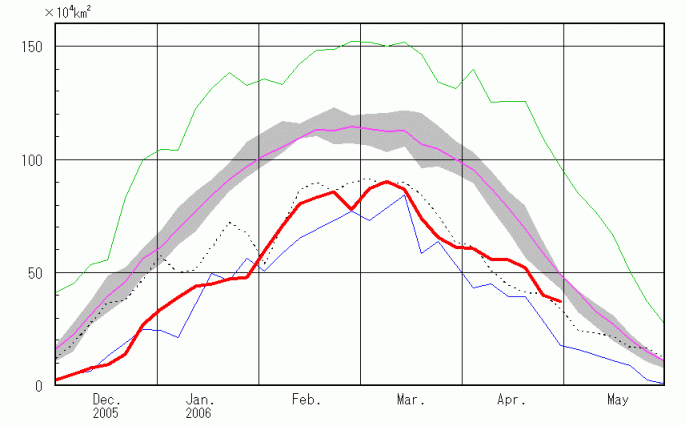 |
1. Overall features
Sea ice area in the Okhotsk Sea was smaller than normal throughout the period from December 2005 to April 2006 (Figure 1). It was the smallest since 1971 in the second 10-days of December and the first 10-days of January. Sea ice area reached its seasonal maximum of 0.90 million square kilometers on 10th March, which was smaller than the normal extent of 1.22 million and the second smallest only to 0.86 million for the year 1984.
Figure 1 Time series of sea ice area in the Sea of Okhotsk until the end of April in 2005-2006 season (red bold line).
Purple line shows the normal for 30 years from 1971 to 2000 and grey area shows the range of the normal class. Dotted line, green line and blue line show time series of last year, maximum and minimum for 1971-2005, respectively.
2. Time sequential description
First of all, sea ice began to form in Shelikhov Bay in the last 10-days of October 2005. Since the last 10-days of December 2005, sea ice had rapidly expanded southward along the eastern coast of Sakhalin. The first date of drift ice in sight at Mombetsu and that at Abashiri were 12th January and 23rd January 2006, respectively. The first date of drift ice on shore at Abashiri and that at Mombetsu were 6th February and 8th February, respectively. These dates are almost the same as normal. (Figure 2(a))
Since the last 10-days of January 2006, drift ice had flowed into the Nemuro Straits. The first date of drift ice in sight and that on shore at Nemuro were 4th February and 5th February, respectively. These dates are earlier than normal. Drift ice frequently flowed into the Pacific Ocean through the Nemuro Straits and Kunashiri Pass during February, but withdrew earlier than normal. The last date of drift ice in sight at Nemuro was 5th March, which is the third earliest since 1946. (Figure 2 (b))
The first date of shore lead appearance at Mombetsu and that at Abashiri were 17th February and 15th February, respectively, both of which are the second earliest since 1956. The last date of drift ice in sight at Abashiri was 25th March, which is the third earliest since 1946.
In early April 2006, drift ice, which had withdrawn to the eastern coast of Sakhalin, moved southward again and approached the coast of northern Hokkaido. The first date of drift ice in sight at Wakkanai was 5th April, which is the latest since 1946 (Figure 2 (c)). Sea ice on the eastern coast of Sakhalin melted slower than normal, and it was observed in Aniva Bay and the Soya Straits even at the end of April 2006 (Figure 2 (d)).
Figure 2 Sea ice extent in the Okhotsk Sea (white area).
Red lines in each panel show the normal ice edge for 30 years from 1971 to 2000.
(Hideki Kaneko, Office of Marine Prediction)
| Home | About Us | Topics | Data and Products | Long-Range Forecast | Library | Site Map | Related Links | Copyright & Disclaimer |